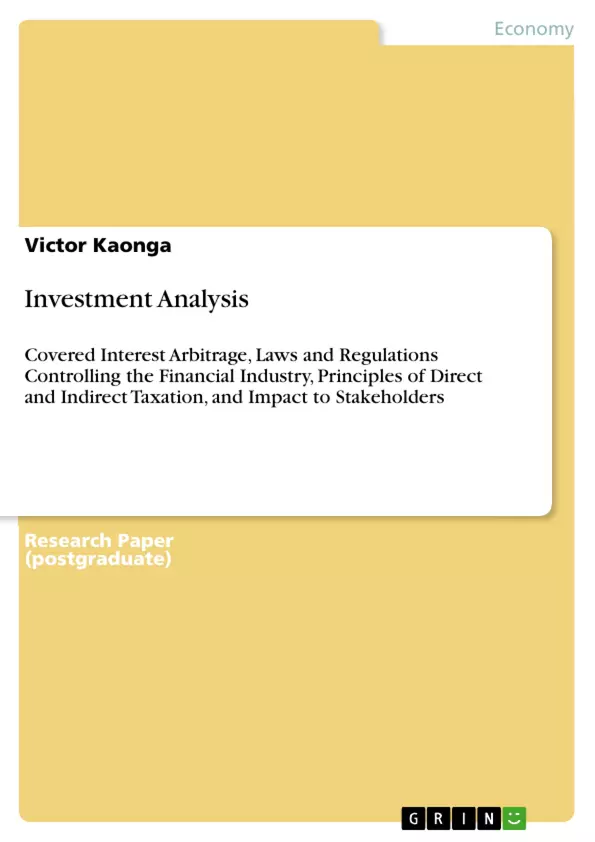Interest rate arbitrage refers to the mechanism in which an investor strategises to profit from differences in interest rates between two countries or financial markets. However, the investor may be taking a risk due to the uncertainties of future currency exchange rates. When the investor incorporates an aspect of hedging while practicing interest rate arbitrage, he is assured to pocket a riskless profit. The term covered interest arbitrage is used to describe the form of interest arbitrage where currency exchange has been hedged using derivative instruments. The investor, therefore, makes simultaneous spot and forward transactions (Fong, Valente & Fung, 2010).
Inhaltsverzeichnis (Table of Contents)
- Covered Interest Arbitrage
- Laws and Regulations Controlling the Financial Industry
- Principles of Direct and Indirect Taxation, and Impact to Stakeholders
- Key Characteristics of Various Types of Securities
- Equity Securities
- Debt Securities
- Derivative Instruments
- Securities Trading Regulations, Policies, and Procedures
- Issues in Global Markets Including LSE
- Portfolio Management
- Appropriate Types of Savings and Investment for Expansion of Air UK & Co
- Principles of Investment Theory
- Underlying Concepts of Market Analysis and Efficiency
Zielsetzung und Themenschwerpunkte (Objectives and Key Themes)
This module explores the key concepts and principles of investment analysis, focusing on the practical application of these principles in various financial scenarios. The module aims to equip students with the theoretical foundation and practical skills required to analyze and evaluate investment opportunities, understand the role of financial institutions, and navigate the complexities of financial markets.
- Covered interest arbitrage and its application in financial markets
- The regulatory framework governing the financial industry, including international and national regulations
- Different types of securities, including equity, debt, and derivative instruments
- The principles of investment theory and their application in real-world investment decisions
- The concepts of market analysis and efficiency in the context of investment decision-making
Zusammenfassung der Kapitel (Chapter Summaries)
- Covered Interest Arbitrage: This chapter introduces the concept of interest rate arbitrage, emphasizing the risk-free profit potential through hedging with derivative instruments. The chapter provides a practical example of covered interest arbitrage, showcasing the calculation of potential profits and the importance of managing currency risk.
- Laws and Regulations Controlling the Financial Industry: This chapter explores the regulatory landscape of the financial industry, highlighting the need for regulations to prevent malpractices and ensure financial stability. The chapter discusses both international and national regulations, focusing on the role of the Bank of England, the BASEL framework, and the Financial Conduct Authority (FCA) in regulating financial institutions in the UK.
Schlüsselwörter (Keywords)
This module focuses on key concepts like covered interest arbitrage, financial regulations, investment analysis, equity securities, debt securities, derivative instruments, portfolio management, and market efficiency. It also explores the application of these concepts in various financial scenarios and their impact on investors, financial institutions, and the overall economy.
- Quote paper
- Victor Kaonga (Author), 2018, Investment Analysis, Munich, GRIN Verlag, https://www.grin.com/document/509661



